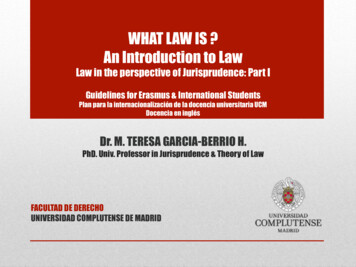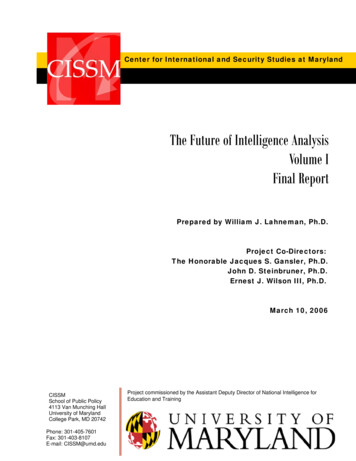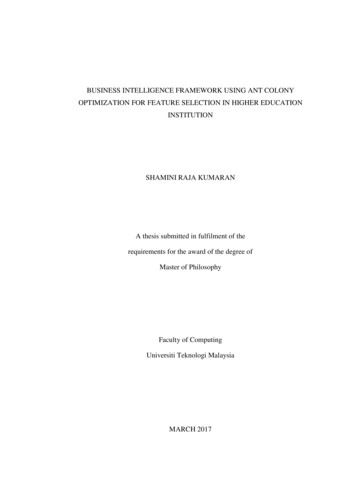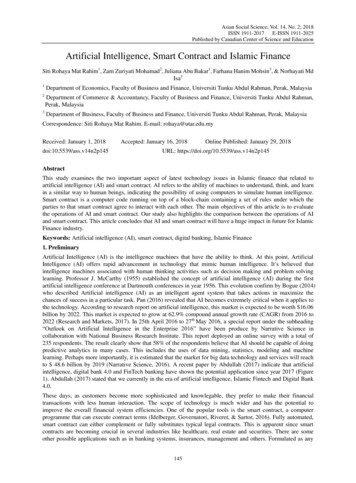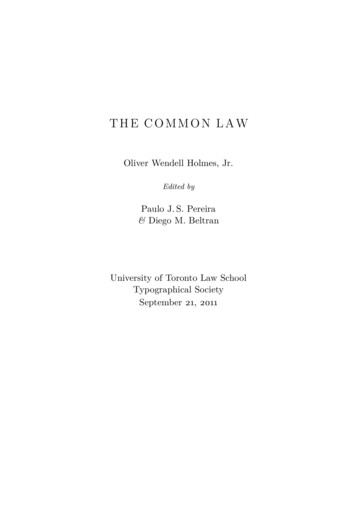
Transcription
THE COMMON LAWOliver Wendell Holmes, Jr.Edited byPaulo J. S. Pereira& Diego M. BeltranUniversity of Toronto Law SchoolTypographical SocietySeptember 21, 2011
Paulo J. S. Pereira & Diego M. Beltran, MMXIThe text of this work is based on the 1881 edition of OliverWendell Holmes, which is now in the public domain. The typography and formatting are licensed under the Creative CommonsAttribution-NonCommercial-NoDerivs 3.0 Unported License.Please send corrections and comments toTypographical.Society@gmail.com.Revision : 1.12
contents1Early Forms of Liability52 The Criminal Law 383 Torts.—Trespass and Negligence714 Fraud, Malice, and Intent.—The Theory of Torts 1175 The Bailee at Common Law 1466 Possession 1837 Contract.—I. History 2198 Contract. II. Elements 2569 Contract.—III. Void and Voidable 27210 Successions—I. After Death—II. Inter Vivos 30011 Successions.—II. Inter Vivos 327Index 361
prefacehis is written in pursuance of a plan which I have long hadin mind. I had taken a first step in publishing a numberof articles in the American Law Review, but I should hardlyhave attempted the task of writing a connected treatise at thepresent time, had it not been for the intention to deliver a courseof Lectures at the Lowell Institute in Boston. That invitationencouraged me to do what was in my power to accomplish mywish. The necessity of preparing for the Lectures made it easierto go farther, and to prepare for printing, and accordingly I didso. I have made such use as I thought fit of my articles in theLaw Review, but much of what has been taken from that sourcehas been rearranged, rewritten, and enlarged, and the greaterpart of the work is new. The Lectures as actually delivered werea good deal simplified, and were twelve in number. The twelfth,however, was a summary of the foregoing eleven, and has beenomitted as not necessary for a reader with the book before him.The limits of such an undertaking as the present must necessarily be more or less arbitrary. Those to which I have confinedmyself have been fixed in part by the limits of the course forwhich the Lecgures were written. I have therefore not attemptedto deal with Equity, and have even excluded those subjects likeBills and Notes, or Partnership, which would naturally requirean isolated treatment, and which do not promise to throw lighton general theory. If, within the bounds which I have set myself,any one should feel inclined to reproach me for a want of greaterdetail, I can only quote the words of Lehuërou, “Nous faisons unethéorie et non un spicilège.”O. W. Holmes, Jr.TBoston, February 8, 1881.
early forms of liabilityhe object of this book is to present a general view of the Object of theCommon Law. To accomplish the task, other tools are needed Bookbesides logic. It is something to show that the consistency of asystem requires a particular result, but it is not all. The life of thelaw has not been logic: it has been experience. The felt necessitiesof the time, the prevalent moral and political theories, intuitionsof public policy, avowed or unconscious, even the prejudices whichjudges share with their fellow-men, have had a good deal moreto do than the syllogism in determining the rules by which menshould be governed. The law embodies the story of a nation’sdevelopment through many centuries, and it cannot be dealt withas if it contained only the axioms and corollaries of a book ofmathematics. In order to know what it is, we must know whatit has been, and what it tends to become. We must alternatelyconsult history and existing theories of legislation. But the mostdifficult labor will be to understand the combination of the twointo new products at every stage. The substance of the law at anygiven time pretty nearly corresponds, so far as it goes, with whatis then understood to be convenient; but its form and machinery,and the degree to which it is able to work out desired results,depend very much upon its past.In Massachusetts to-day, while, on the one hand, there area great many rules which are quite sufficiently accounted for bytheir manifest good sense, on the other, there are some whichcan only be understood by reference to the infancy of procedureamong the German tribes, or to the social condition of Romeunder the Decemvirs.I shall use the history of our law so far as it is necessaryto explain a conception or to interpret a rule, but no further.In doing so there are two errors equally to be avoided both bywriter and reader. One is that of supposing, because an ideaT5
EARLY FORMS OF LIABILITYseems very familiar and natural to us, that it has always been so.Many things which we take for granted have had to be laboriouslyfought out or thought out in past times. The other mistake isthe opposite one of asking too much of history. We start withman full grown. It may be assumed that the earliest barbarianwhose practices are to be considered, had a good many of thesame feelings and passions as ourselves.The first subject to be discussed is the general theory of liabilitycivil and criminal. The Common Law has changed a good dealsince the beginning of our series of reports, and the search aftera theory which may now be said to prevail is very much a studyof tendencies. I believe that it will be instructive to go back tothe early forms of liability, and to start from them.Origin of Legal Procedure in the Composition for VengeanceIt is commonly known that the early forms of legal procedurewere grounded in vengeance. Modern writers have thought thatthe Roman law started from the blood feud, and all the authoritiesagree that the German law begun in that way. The feud led to thecomposition, at first optional, then compulsory, by which the feudwas bought off. The gradual encroachment of the compositionmay be traced in the Anglo-Saxon laws, 1 and the feud was prettywell broken up, though not extinguished, by the time of Williamthe Conqueror. The killings and house-burnings of an earlier daybecame the appeals of mayhem and arson. The appeals de paceet plagis and of mayhem became, or rather were in substance,the action of trespass which is still familiar to lawyers. 2 Butas the compensation recovered in the appeal was the alternativeof vengeance, we might expect to find its scope limited to thescope of vengeance. Vengeance imports a feeling of blame, and anopinion, however distorted by passion, that a wrong has been done.1E.g. Ine, c. 74; Alfred, c. 42; Ethelred, IV. 4, § 1.Bract., fol. 144, 145; Fleta, I. c. 40, 41; Co. Lit. 126b; 111 Hawkins, P.C.,Bk. 2, ch. 23, § 15.2 P. J. S. Pereira & D. M. Beltran, MMXI6The Origin ofLegal Procedurein the Composition forVengeance
EARLY FORMS OF LIABILITYIt can hardly go very far beyond the case of a harm intentionallyinflicted: even a dog distinguishes between being stumbled overand being kicked.Whether for this cause or another, the early English appealsfor personal violence seem to have been confined to intentionalwrongs. Glanvill 3 mentions mêlées, blows, and wounds,—allforms of intentional violence. In the fuller description of suchappeals given by Bracton 4 it is made quite clear that they werebased on intentional assaults. The appeal de pace et plagis laidan intentional assault, described the nature of the arms used,and the length and depth of the wound. The appellor also hadto show that he immediately raised the hue and cry. So whenBracton speaks of the lesser offences, which were not sued by wayof appeal, he instances only intentional wrongs, such as blows withthe fist, flogging, wounding, insults, and so forth. 5 The cause ofaction in the cases of trespass reported in the earlier Year Booksand in the Abbreviatio Placitorum is always an intentional wrong.It was only at a later day, and after argument, that trespasswas extended so as to embrace harms which were foreseen, butwhich were not the intended consequence of the defendant’s act. 6Thence again it extended to unforeseen injuries. 7It will be seen that this order of development is not quiteconsistent with an opinion which has been held, that it was acharacteristic of early law not to penetrate beyond the externalvisible fact, the damnum corpore corpori datum. It has beenthought that an inquiry into the internal condition of the defendant, his culpability or innocence, implies a refinement of juridicalconception equally foreign to Rome before the Lex Aquilia, andto England when trespass took its shape. I do not know any very34567Lib. I. c. 2, ad fin.Bract., fol. 144a, “assulto præmeditato.”Fol. 155; cf. 103b.Y.B. 6 Ed. IV. 7, pl. 18.Ibid., and 21 H. VII. 27, pl. 5. P. J. S. Pereira & D. M. Beltran, MMXI7
EARLY FORMS OF LIABILITYsatisfactory evidence that a man was generally held liable eitherin Rome 8 or England for the accidental consequences even of hisown act. But whatever may have been the early law, the foregoingaccount shows the starting-point of the system with which wehave to deal. Our system of private liability for the consequencesof a man’s own acts, that is, for his trespasses, started from thenotion of actual intent and actual personal culpability.The original principles of liability for harm inflicted by anotherperson or thing have been less carefully considered hitherto thanthose which governed trespass, and I shall therefore devote therest of this Lecture to discussing them. I shall try to show thatthis liability also had its root in the passion of revenge, and topoint out the changes by which it reached its present form. But Ishall not confine myself strictly to what is needful for that purpose,because it is not only most interesting to trace the transformationthroughout its whole extent, but the story will also afford aninstructive example of the mode in which the law has grown,without a break, from barbarism to civilization. Furthermore, itwill throw much light upon some important and peculiar doctrineswhich cannot be returned to later.A very common phenomenon, and one very familiar to thestudent of history, is this. The customs, beliefs, or needs of aprimitive time establish a rule or a formula. In the course ofcenturies the custom, belief, or necessity disappears, but therule remains. The reason which gave rise to the rule has beenforgotten, and ingenious minds set themselves to inquire how it isto be accounted for. Some ground of policy is thought of, whichseems to explain it and to reconcile it with the present state ofthings; and then the rule adapts itself to the new reasons whichhave been found for it, and enters on a new career. The oldform receives a new content, and in time even the form modifies8D. 47. 9. 9. P. J. S. Pereira & D. M. Beltran, MMXI8Subject of thisLecture, Indirect Liability forServants, Animals, &c.
EARLY FORMS OF LIABILITYitself to fit the meaning which it has received. The subject underconsideration illustrates this course of events very clearly.I will begin by taking a medley of examples embodying asmany distinct rules, each with its plausible and seemingly sufficientground of policy to explain it.A man has an animal of known ferocious habits, which escapesand does his neighbor damage. He can prove that the animalescaped through no negligence of his, but still he is held liable.Why? It is, says the analytical jurist, because, although he wasnot negligent at the moment of escape, he was guilty of remoteheedlessness, or negligence, or fault, in having such a creature atall. And one by whose fault damage is done ought to pay for it.A baker’s man, while driving his master’s cart to deliver hotrolls of a morning, runs another man down. The master has topay for it. And when he has asked why he should have to pay forthe wrongful act of an independent and responsible being, he hasbeen answered from the time of Ulpian to that of Austin, that itis because he was to blame for employing an improper person. Ifhe answers, that he used the greatest possible care in choosinghis driver, he is told that that is no excuse; and then perhaps thereason is shifted, and it is said that there ought to be a remedyagainst some one who can pay the damages, or that such wrongfulacts as by ordinary human laws are likely to happen in the courseof the service are imputable to the service.Next, take a case where a limit has been set to liability whichhad previously been unlimited. In 1851, Congress passed a law,which is still in force, and by which the owners of ships in all themore common cases of maritime loss can surrender the vessel andher freight then pending to the losers; and it is provided that,thereupon, further proceedings against the owners shall cease.The legislators to whom we owe this act argued that, if a merchantembark a portion of his property upon a hazardous venture, itis reasonable that his stake should be confined to what he putsat risk,—a principle similar to that on which corporations have P. J. S. Pereira & D. M. Beltran, MMXI9
EARLY FORMS OF LIABILITYbeen so largely created in America during the last fifty years.It has been a rule of criminal pleading in England down intothe present century, that an indictment for homicide must setforth the value of the instrument causing the death, in order thatthe king or his grantee might claim forfeiture of the deodand, “asan accursed thing,” in the language of Blackstone.I might go on multiplying examples; but these are enough toshow the remoteness of the points to be brought together.—As afirst step towards a generalization, it will be necessary to considerwhat is to be found in ancient and independent systems of law.There is a well-known passage in Exodus, 9 which we shall have Mosaic Lawto remember later: “If an ox gore a man or a woman, that theydie: then the ox shall be surely stoned, and his flesh shall notbe eaten; but the owner of the ox shall be quit.” When we turnfrom the Jews to the Greeks, we find the principle of the passage Greek Lawjust quoted erected into a system. Plutarch, in his Solon, tells usthat a dog that had bitten a man was to be delivered
The Common Law has changed a good deal since the beginning of our series of reports, and the search after a theory which may now be said to prevail is very much a study of tendencies. I believe that it will be instructive to go back to the early forms of liability, and to start from them. Origin of Legal Procedure in the Composition for Vengeance It is commonly known that the early forms of .




